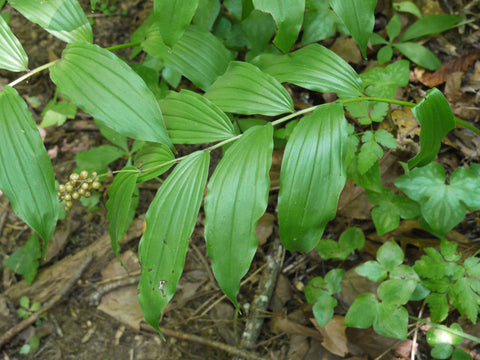About Solomons Seal Plant
Solomon’s Seal (Polygonatum) is a native perennial that adds graceful structure, texture, and understated beauty to shaded landscapes. Beloved by gardeners and woodland plants, Solomon’s Seal features arching stems, dangling tubular flowers, and green or yellow variegated foliage. Not only is it attractive to native pollinators and easy to grow, but its strikingly simple flowers, broad leaves, and late-season berries also make it a nice garden plant.
Solomon's Seal grow well in partial shade.
Solomon’s Seal emerges in the spring with long, arching stems that rise from underground rhizomes. These stems are studded with alternating pairs of small bell-shaped white or creamy flowers that dangle beneath the leaves. The delicate blooms give the plant an airy, gentle appearance and cover the plant in late spring. Pollinators like bees, butterflies, and hummingbirds are drawn to the subtle white flowers in search of nectar, when other native woodland plants may not have bloomed yet.
Solomon’s Seal grows attractive small blue-black berries that form in late summer to fall. Birds and other wildlife forage on these tiny fruits, making the plant a good choice for food gardens, as well as for seasonal visual interest beyond the flowers. Alternating compound leaves on the arching stems are lance-shaped and bright green, providing good foliage cover for the plant throughout the season. In the fall, some selections turn yellow.
Solomon’s Seal likes partial to full shade and well-drained, evenly moist soil with high organic matter. It is a low-maintenance perennial that will spread slowly through underground rhizomes, forming clumps or eventually naturalizing. This growth habit makes it ideal for woodland gardens, shaded borders, or under trees and shrubs. It also works well with other shade-loving plants like ferns, trilliums, and hostas.
Gardeners love Solomon’s Seal for its combination of beauty, ease of care, and wildlife value.
The arching stems and subtle white flowers give a vertical element to shade gardens without competing with nearby plants. This adaptable and durable plant is long-lived, easy to grow, and provides interest for multiple seasons.



